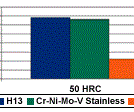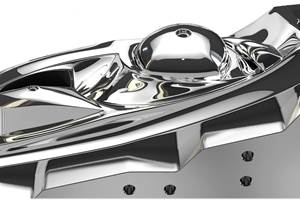Breaking the H-13 Stereotype For the Common Mold
A look at the new grades and steel making practices that are available to address the day-to-day issues that occur in the operation of a mold.
When high production tooling is considered in plastic injection molding, the goal is to use a grade that is capable of withstanding the operational issues, along with ease in manufacturing and heat treatment. Through the years, grades like AISI H13 were able to give the customer what was needed from a strength perspective. Then, secondary remelting procedures were introduced in the manufacture of the steel to provide added cleanliness to the grade, as well as high polishability and texturability to the steel.
But just as technology has changed in the introduction of new plastic molding materials, new manufacturing techniques, and even greater demands on cycle time, so are there changes in mold material requirements. The common mold is not so common anymore, and because of this, there are new grades and steel making practices that are available to help address the new concerns of the industry. This discussion will look at several different alternatives to the day-to-day issues that occur in the operation of a mold.
Corrosion Resistance
Modified 400 Series Stainless Grades
H13 has been a robust grade in terms of strength, heat treatment capability, size availability and machinability. But, as the need to extend tooling life grows, its lack of ability to resist the attack of chemically aggressive plastic, surface damage due to moisture and humidity, and cooling water contamination, reduces its effectiveness. More corrosion-resistant tooling materials should be considered.
In the past, the tooling material of choice was an AISI 420-type stainless steel. It had the same mechanical strength capabilities as an H13, and the remelted versions of this grade provided high polishability, texturability and relatively good corrosion resistance. However, when conditions existed in which high stresses, marginal heat treatment and corrosion aligned, cracking of the material could occur. This caused toolmakers to shy away from its use.
In an effort to provide a grade with properties similar to an H13 in terms of strength, polishability, machinability and with sufficient corrosion resistance, a modified martensitic stainless alloy was developed. Its key advantages are that even in larger cross sections, a uniform structure forms after heat treatment while its toughness is comparable to that of H13. The corrosion resistance of this grade exceeds that of a 420 stainless steel. This grade, coupled with design modifications (for example, the use of nontapered pipe plugs) can reduce cracking concerns significantly (see Figures 1 and 2).
Precipitation Hardening Stainless Alloy
When further corrosion resistance is required—in a grade needing hardness levels up to 50 HRC—a material that transforms by precipitation has been introduced. This grade, due to its lower carbon content and high levels of nickel and chromium, is extremely corrosion resistant. With a wide (35-50 HRC) range of working hardness, its corrosion resistance, stress corrosion resistance and toughness is greater than that of a 420 stainless steel. It is useful in tools that must be EDM’d because no hard white layer is formed.
In the following case study, this material is used in the hardness range common for an H13, but in an application where chromium plating would have been required to provide sufficient corrosion resistance.
Application: Rain water bracket; four-cavity injection mold (see Figure 3)
Work Material: Polyvinyl Chloride (PVC)
Previous Tooling Materials:
- Improved P20 with chromium plating
- Modified 420 stainless steel at 50HRC
Major Issue:
- Chromium plating proved unsatisfactory due to difficulty in getting into recesses
- 420 type stainless required major refurbishments after 50,000 parts due to corrosion
New Tooling Material: Corrosion-resistant precipitation hardening alloy, aged to 46-48 HRC
Results: This steel has run more than 250,000 shots with no major issues. The tool is examined every three months. Only slight staining is found, which is given a quick polish and then the tool is put back into production.
High Toughness and Improved Cycle Time: New Cr-Mo-V alloys
Premium H13, in order to enhance its high ductility and toughness, is remelted to achieve better directional uniformity and reduce impurities. The most up-to-date remelting enhancements in this regard, are units in which the ingot is fully contained, permitting automatic slag feeding, auto-matic immersion depth and melt rate control, as well as remelting under protective atmosphere as shown in Figure 4.
This process technology allows the steel provider the best properties capable in an H13 chemistry. But sometimes even that is not enough. For example, in applications where slender cores that are fragile are present, the toughness level of even the toughest H13 is not good enough. In that case, grades with higher toughness capabilities are required. One such grade has been used very successfully for these applications. With toughness levels that exceed that of the superior levels of remelted H13 by 40 percent at room temperature, this grade also will help resist the propagation of cracks already present in the steel, for example from EDM processing or welding.
Another advantage to this grade is heat conductivity is greater than that of H13, so cycle times can be reduced. Not only is the thermal conductivity improved, but the heat diffusion is improved over an H13. For molds where higher hardness grades are required and improved cycle time is required, this alloy and other higher hardness versions like it, are the grades of choice (see Figures 5 and 6).
High Wear Resistance Tooling Materials Using PM and Sprayform Technology
It would be a serious omission not to mention the advancements in technology over the past few years to enhance the wear resistance of tooling materials. The approach has been twofold: (1) to provide steels that can be readily coated and (2) to create manufacturing techniques that will provide highly wear-resistant grades, which can be coated if needed.
A grade like H13 can be coated or surface treated by the use of physical vapor deposition (PVD), nitriding and ferritic nitrocarburizing. But the substrate hardness is too low in high wear applications. In comparison, high hardness grades like S7, A2 and D2 obtain their highest hardness by using tempering temperatures below 500°F. This situation prevents the use of higher temperature coatings (PVD and nitriding) and would provide an unstable substrate for even higher temperature processes like chemical vapor deposition and thermoreactive diffusion (CVD and TD). Developments over the past few years have created new steels to replace all these alloy types with similar and improved wear resistance, but obtaining their high hardness levels through tempers exceeding 1000°F.
New grades now exist that have very high toughness, are weldable and coatable, as well as grades containing carbides with high wear resistance that are coatable as well.
In addition, new technology exists in steel manufacturing to create highly wear-resistant grades without the fear of segregation. Most of us are now familiar with powder metallurgical (P/M) grades that can be used in abrasive and corrosive plastics applications.
New P/M steel practices—which help to develop steels of the highest micro-cleanliness with the best size and uniformity of carbides with no segregation—permit the use of these grades for high polishability molds and applications sensitive to cracking issues. A more recent development has been the use of spray form technology, in which carbide containing grades of larger dimensions than can be produced in a powder metallurgical process are produced for applications where higher wear resistance is required.
An example of where this spray form technology should be used is in the case of injection molded magnets, manufactured from plastic containing very abrasive magnetic particles. Small three-inch diameter round by 3.14-inch long molds were manufactured from an extremely wear-resistant, high chromium, molybdenum, and vanadium containing alloy. It was used in place of a powder metallurgical steel containing 10 percent vanadium. The powder metallurgical material was abrasively wearing. This alloy improved the life of the mold by 20 percent.
High Polishability Requirements: Vacuum Arc Remelted Alloys
For most applications where high polishability is required, the remelting technology available to produce H13 is more than sufficient for the vast majority of applications. But in high polishability lens molds and in applications where even minor imperfections will affect part performance, vacuum arc remelted material is available at very high cleanliness levels.
For example, a vacuum arc remelted grade was used to replace an alloy steel, PVD-coated grade where polishability was important on a polycarbonate injection mold manufacturing an incubator. It had improved polishability and a better surface finish without the need for coating.
Conclusions
While H13 still has a place in a large number of molding applications, it has been surpassed for many molding needs. New steel manufacturing techniques—along with new product development—have led to even better choices. A clear understanding of the need for the tooling is required, as well as knowledge of the grades that are available.
Related Content
How to Achieve the Best Mold Finish
A look at factors that impact the polishability of tool steels and recommendations for obtaining a high-gloss finish.
Read MoreMold Material Enables Additive Manufacturing Capabilities for Tooling
Uddeholm USA features its mold material Corrax as the first additive manufacturing (AM) powder made for tooling. Corrax is a stainless steel made for AM with corrosion resistance and polishability.
Read MorePTXPO 2025: Moldmaking Meets Molding for Innovation and Connection
PTXPO showcased technology, partnerships and problem-solving across moldmaking and molding, spotlighting automation, AI, materials, community-driven innovation and more.
Read MoreVIDEO: AM Powder Addresses Current Inefficiencies, Sustainability and Skills Gap
Steel supplier discusses high thermal conductivity metal powders that also address the skills gaps via user-friendly materials and promote sustainability via durability and higher cycle counts.
Read MoreRead Next
Cost Savings for Mold Materials: Consider the Details
Ways to reduce costs that are not related to the price per pound of the mold material.
Read MoreHow to Use Strategic Planning Tools, Data to Manage the Human Side of Business
Q&A with Marion Wells, MMT EAB member and founder of Human Asset Management.
Read MoreHow to Use Continuing Education to Remain Competitive in Moldmaking
Continued training helps moldmakers make tooling decisions and properly use the latest cutting tool to efficiently machine high-quality molds.
Read More


























